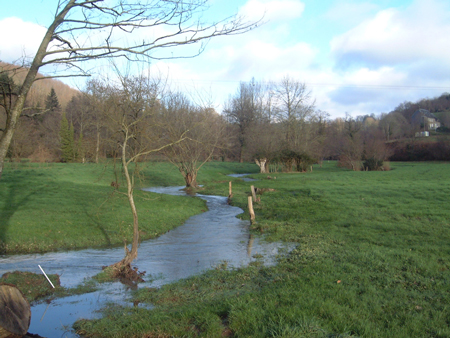Headwater streams are the largest interface between land and water and make up the majority of global river habitats. Understanding the hydrology and ecology of small streams is therefore critical to protecting aquatic ecosystems and ensuring human water security.

However, headwater streams experience huge swings in water flow, temperature, and chemistry. This fluctuation makes it difficult to predict carbon and nutrient fluxes on the basis of characteristics of the land that headwater streams drain. Predicting stream behavior is further complicated by the sheer number of headwaters and the prohibitive cost of high-frequency water quality monitoring.
To discuss how new and old water quality data can help scientists to better understand headwater streams, researchers gathered for a 2-day international workshop in Rennes, France, in March 2017. The workshop was funded by the Earth Sciences and Astronomy Observatory of Rennes (OSUR) and the French Continents and Coasts Initiative (EC2CO). Both programs are part of the French National Center for Scientific Research (CNRS).
Specifically, workshop participants addressed the following questions:
- How can researchers integrate multiple, nonuniform data sources such as occasional sampling of multiple points in the stream, high-frequency time series, and agency water quality data?
- What are the limits to extrapolating high-frequency data from a single catchment?
- What scaling tools can address management issues and improve hypothesis testing?
Working groups developed synthesis papers before and during the meeting on the following topics:
- relationships between water chemistry and water discharge across spatial and temporal scales
- long-term changes in seasonality as indicators of ecosystem health and efficacy of management actions
- optimizing water quality monitoring designs
- synchrony and stationarity of headwater catchment chemistry
- novel modeling techniques to link hydrology with biogeochemistry
Current water quality regulatory frameworks are often a consequence of historical priorities and choices rather than contemporary needs.
One recurrent discussion point was that current water quality monitoring schemes and regulatory frameworks are often a consequence of historical priorities and choices rather than contemporary needs. For example, current monitoring designs capture annual loads from large catchments relatively well, but because of bias in temporal and spatial sampling they cannot identify problem times and locations through the stream network. If water quality targets are not ecologically relevant or if monitoring designs are not able to evaluate compliance, they are unlikely to usefully inform management efforts.
Improved management may take decades to improve performance.
Time lags are another major challenge because improved management may take decades to improve performance. Participants discussed the effectiveness of regulatory goals, the likelihood of interventions reaching those goals, and how monitoring frameworks could better integrate basic research.
In addition to participants writing a review paper about regulation and management, other papers and proposals resulting from this meeting will cover emergent properties in water quality variance; the characterization, classification, and prediction of solute variability in catchments; and new metrics of water quality data.
To overcome some of the challenges and apprehensions associated with interdisciplinary research, meeting participants will prepare a commentary article that will be submitted to an appropriate journal consisting of two letters. The first letter will be written by hydrologists to aquatic ecologists; the second letter will be addressed in the reverse direction. The letters will explore what disciplinary differences prevent these scientists from working together. Specifically, what does the other side get wrong, what is intimidating or confusing about the other science, and what can each camp offer their colleagues across the stream?
Additional pictures and a list of participants are available on the OSUR website.
—Benjamin W. Abbott (email: [email protected]), Earth and Environmental Sciences, Michigan State University, Lansing; Gilles Pinay, French National Center for Scientific Research (CNRS), University of Rennes 1, France; and Tim Burt, Durham University, UK
Citation:
Abbott, B. W.,Pinay, G., and Burt, T. (2017), Protecting water resources through a focus on headwater streams, Eos, 98, https://doi.org/10.1029/2017EO076897. Published on 07 July 2017.
Text © 2017. The authors. CC BY-NC-ND 3.0
Except where otherwise noted, images are subject to copyright. Any reuse without express permission from the copyright owner is prohibited.

